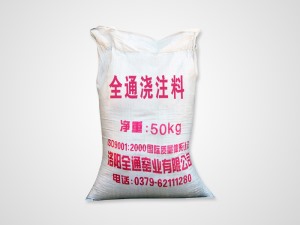Talking about the knotting process of wear-resistant ramming material
The whole process of wear-resistant ramming material has many steps, and knotting is some of the more important processes. And the process of knotting can also affect the service life of the furnace. Ramming material and other indeterminate shapes of similar materials Compared with refractory materials, it is dry or semi-dry and loose, and a dense structure is obtained by strong ramming. Only when it is heated to the sintering temperature, the combination will have strength. After the ramming material is formed, it can be used according to the hardening characteristics of the mixture. Different heating methods can promote its hardening or sintering. If it contains inorganic chemical binder, it can be demolded and baked after it hardens to a considerable strength; if it contains thermoplastic carbon mixture, it will be demolded after cooling and it has a considerable strength, and it should be quickly used before use. Heating to make it coking; without the binder that hardens at room temperature, what should we pay attention to in the process of knotting with a die after tamping to ensure that it does not affect the service life of the furnace?
1. The basic is of course the standardized operation process, but in addition, there are many precautions in the knotting process of the wear-resistant ramming material. For example, ensure the power supply and water supply before knotting The improvement of the system should also be prepared in advance by the operators on each project. Of course, it also includes that operators are prohibited from carrying any combustibles on the job site, and of course, mobile phones, keys and other items are also included.
2. Sand adding in the process of wear-resistant ramming material is a process with strict requirements. For example, sand must be added at one time, and should not be added in batches. Of course, when adding sand, make sure that the sand is spread on the bottom of the furnace. Do not pile up in a pile, otherwise it will cause the particle size of the sand to separate.
3. When tying the knot, I have to operate it according to the method of shaking first and then vibrating. And pay attention to the method to ensure that the process of operation should be light and then heavy. And the joystick should be inserted to the bottom at one time, and every time When inserting the rod, shake it 8 to 10 times.
4. After the bottom of the furnace is knotted, make sure that it can be put into the dry pot stably. In this way, it can ensure that the shape is relatively standardized, and it will generally be a standard annular 3-corner ring. Of course, in the entire knotting process, the demand There are many more processes to pay attention to, and each process cannot be ignored.

Related News
- Introduction of construction method of ramming material in intermediate frequency furnace
- How to choose the material of furnace lining
- The difference between rammer and castable
- Application direction of intermediate frequency furnace refining
- Introduction to the construction method of dry ramming material
- Do you know the production process and control points of breathable bricks?
- The application of argon blowing technology at the bottom of the intermediate frequency furnace
- Method for prolonging service life of intermediate frequency furnace lining
- In addition to diffused breathable bricks, there are those types of breathable bricks
- What are the advantages of coil cement
- What are the functions of ladle breathable bricks
- Preparation before lining of intermediate frequency furnace
- Which furnace lining material should be used for the ramming material of the intermediate frequency furnace?
- How to use the furnace lining and how to build the furnace
- Introduction of Insulation of Coil Clay
- Common functions of coil cement of intermediate frequency furnace
- The method of improving the life of ladle breathable brick
- Causes of damage to ventilation bricks
- Selection of lining materials for intermediate frequency furnaces
- Matters needing attention in the knotting process of wear-resistant ramming material


